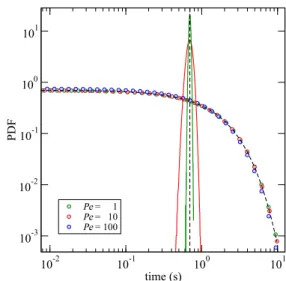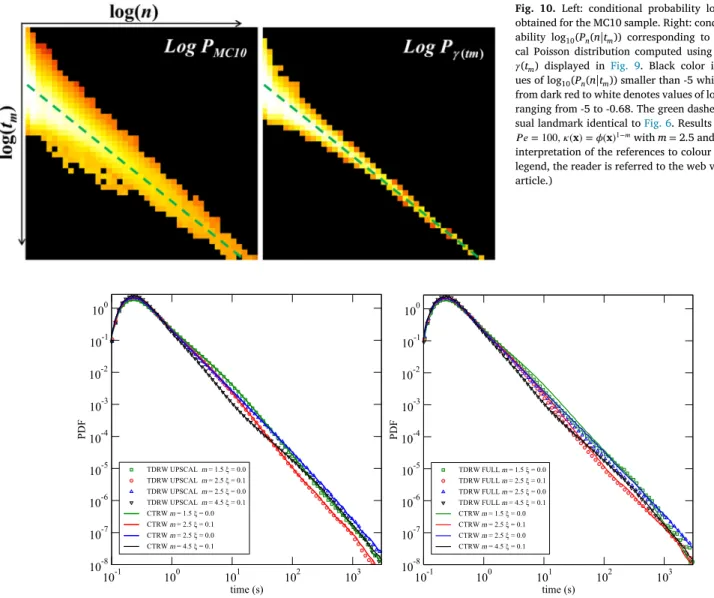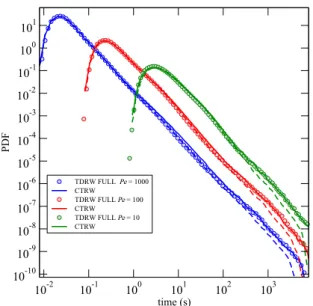HAL Id: hal-02999509
https://hal.archives-ouvertes.fr/hal-02999509
Submitted on 10 Nov 2020
HAL is a multi-disciplinary open access
archive for the deposit and dissemination of
sci-entific research documents, whether they are
pub-lished or not. The documents may come from
teaching and research institutions in France or
abroad, or from public or private research centers.
L’archive ouverte pluridisciplinaire HAL, est
destinée au dépôt et à la diffusion de documents
scientifiques de niveau recherche, publiés ou non,
émanant des établissements d’enseignement et de
recherche français ou étrangers, des laboratoires
publics ou privés.
Characterization and upscaling of hydrodynamic
transport in heterogeneous dual porosity media
Philippe Gouze, Alexandre Puyguiraud, Delphine Roubinet, Marco Dentz
To cite this version:
Philippe Gouze, Alexandre Puyguiraud, Delphine Roubinet, Marco Dentz. Characterization and
upscaling of hydrodynamic transport in heterogeneous dual porosity media. Advances in Water
Re-sources, Elsevier, 2020, 146, �10.1016/j.advwatres.2020.103781�. �hal-02999509�
AdvancesinWaterResources146(2020)103781
ContentslistsavailableatScienceDirect
Advances
in
Water
Resources
journalhomepage:www.elsevier.com/locate/advwatres
Characterization
and
upscaling
of
hydrodynamic
transport
in
heterogeneous
dual
porosity
media
Philippe
Gouze
a,∗,
Alexandre
Puyguiraud
b,
Delphine
Roubinet
a,
Marco
Dentz
b a Géosciences, Université de Montpellier, CNRS, Montpellier, Franceb Spanish National Research Council (IDAEA-CSIC), 08034 Barcelona, Spain
a
r
t
i
c
l
e
i
n
f
o
Keywords:
Non-Fickian dispersion Heterogeneous porous media Upscaling
Time domain random walk Continuous time random walk Dual multirate mass transfer model
a
b
s
t
r
a
c
t
Westudytheupscalingofpore-scaletransportofpassivesoluteinacarbonaterocksample.Itischaracterizedby microporousregionsdisplayingheterogeneousporositydistributionthatareaccessibleduetodiffusiononly,and astronglyheterogeneousmobileporespace,characterizedbyabroaddistributionofflowvelocities.Weobserve breakthroughcurvesthatarecharacterizedbystrongtailing,whichcanbeattributedtovelocityvariabilityin theflowingmediumportion,andsoluteretentioninthemicroporousspace.Usingaccuratenumericalflowand transportsimulations,weseparatethesetwomechanismsbyanalyzingthestatisticsofresidencetimesinthe mobilephase,andthetrappingandresidencetimestatisticsinthemmobilephase.Weemployacontinuoustime randomwalkframeworkinordertoupscaletransportusingaparticlebasedimplementationofmobile-immobile masstransfer,andheterogeneousadvection.Thisapproachisbasedonthestatisticsofthecharacteristicmobile andimmobileresidencetimes,andmasstransferratesbetweenthetwocontinua.Whileclassicalmobile-immobile approachesmodelmasstransferasaconstantrateprocess,wefindthatthetrappingrateincreaseswithincreasing mobileresidencetimesuntilitreachesaconstantasymptoticvalue.Basedonthesefindingsandthestatistical characteristicsoftravelandretentiontimes,wederiveanupscaledLagrangiantransportmodelthatseparatesthe processesofheterogeneousadvectionanddiffusionintheimmobilemicroporousspace,andprovidesaccurate descriptionsoftheobservednon-Fickianbreakthroughcurves.Theseresultsshedlightontransportupscalingin highlycomplexdual-porosityrocksforwhichmobile-immobilemasstransferarecontrolledbyadualmultirate processcontrolledbytheheterogeneityofboththeflowfieldintheconnectedporosityandthediffusioninthe no-flowregions.
1. Introduction
Solutetransport in thelaminarflow throughthevoid spaceof a porousmediumisduetomoleculardiffusionandadvection.Despitethe simplicityofthesefundamentalprocesses,observedtransportis char-acterizedbycomplexfeaturessuchasstrongbreakthroughcurve tail-ing, non-Gaussianconcentration distributions,anomalous dispersion, incompletemixing,andintermittentLagrangianflowproperties(Cortis andBerkowitz,2004;Seymouretal.,2004;Bijeljicetal.,2011;DeAnna etal.,2013;Bijeljicetal.,2013;Kangetal.,2014;Holzneretal.,2015; Moralesetal.,2017).Thesebehaviorsareduetotheintricatestructure oftheporespace,andthemulti-scaleheterogeneitydistribution,which causebroaddistributionsofadvectiveanddiffusivemasstransfertime scalesandtransportpathways(Bijeljicetal.,2011;Portaetal.,2015; Puyguiraudetal., 2019a).The understandingofthese heterogeneity mechanisms,andtheirquantificationinupscaledtransportmodelsare keyissuesin manyacademicandengineeringapplicationsconcerned
∗Correspondingauthor.
E-mailaddress:Philippe.Gouze@UMontpellier.fr(P.Gouze).
withthelargescale(macroscopic)predictionofthefateof conserva-tiveandreactivesolutesingeologicalandengineeredmedia,suchas theassessmentofgroundwatercontaminationandremediation, geolog-icalstorageofnuclearwaste,geothermalenergyproduction,and un-dergroundstorageofcarbondioxide(DomenicoandSchwartz,1997; PoinssotandGeckeis,2012;Niemietal.,2017).
Classical upscaling approaches quantify Darcy scale transport in terms of hydrodynamic dispersion coefficients (Bear, 1972), which incorporatethe large scale dispersive effect of pore-scale ve-locity fluctuations. The key issue is evidently the determination of the macroscopic dispersion coefficient. For instance, de Jos-selindeJong (1958)andSaffman(1959)usedLagrangianstochastic modelsforpore-scaleparticlemotioninordertoderiveexpressionsfor thehydrodynamicdispersioncoefficients.Theirapproachesarebased onthefactthatvelocitiesvaryontypicallengthscales,theporelengths. Thus,particlesspendmoretimeinlowthaninhighflowvelocity re-gions.Thisbehavior,whichliesattheoriginofpore-scaleLagrangian intermittency(Dentzetal.,2016),ismodeledbyadistributionoftravel
https://doi.org/10.1016/j.advwatres.2020.103781
Received22April2020;Receivedinrevisedform10September2020;Accepted5October2020 Availableonline8October2020
times.Thespatialtransitionsandthetransitiontimesdependonboththe porevelocitiesandmoleculardiffusion.Sincethesepioneeringworks, hydrodynamicdispersionanditsdependenceonthelocalPécletnumber (theratioofthecharacteristicdiffusiontimetotheadvectiontime)was thesubjectofnumerousexperimental,numericalandtheoretical investi-gations(Scheven,2013;Swansonetal.,2015;Pfannkuch,1963;Rashidi etal.,1996;Jouraketal.,2013;BijeljicandBlunt,2006).Systematic upscalingapproacheshavebeenbasedongeneralizedTaylordispersion theory(Brenner,1980;Sallesetal.,1993),volumeaveraging(Quintard andWhitaker,1994;Davitetal.,2012;2013)andcontinuoustime ran-domwalk(CTRW) (BijeljicandBlunt,2006).
CTRWmethodssimilartotheapproachesinvolvedintheworksof
deJosselindeJong (1958)andSaffman(1959)wereusedtomodel non-Fickian pore-scale transport features such as anomalous disper-sion,breakthroughcurvestailingandintermittentLagrangianparticle velocities(Bijeljic etal., 2011; De Annaet al., 2013; Gjetvajet al., 2015;Kangetal.,2014; Puyguiraudetal.,2019b). The implementa-tionofCTRWisoftenhandledbymodelingparticletransportthrough transitionsoverfixedspatialscalescharacterizedbyrandomtransition times(Berkowitzetal.,2006).Thetimedomainrandomwalk(TDRW) methodthatwillbeusedinthisstudy,isalsobasedonparticles mo-tionoverfixeddistance.Transitiontimesaredeterminedkinematically fromtheEulerianflowfieldandthespatiallydistributedproperties,for instancetheporosityanddiffusivity,thatcanbemappedeitherfrom tomographicimagingorfrom(statistical)models.Thus,thesemethods provideameanstorelatepore-scaleflowpropertiestoDarcyscale trans-portbehavior(Bijeljicetal.,2011;Puyguiraudetal.,2019,2020).
Thepresenceofimmobilemediumregionsthatconsistofdeadend pores,regionsoflowflowinthewakeofsolidgrainsandmicroporosity wherediffusiondominatesarecommonfeaturesofporousmediasuch asreservoirrocks.ThelargedifferenceintermsofPécletnumber be-tweenthesezonesoftheporousmediaandtheconnectednetworkof poresthatformstheusualmacroporosity(theflowingporosity)supports theuseofdualcontinuummobile-immobilemasstransferapproaches firstproposedby vanGenuchtenandWierenga(1976).Thisapproach hasbeenwidelyusedtotakeintoaccounttheoften-encountered con-trolofspatiallydistributeddiffusivezonesontheoverallhydrodynamic transportandspecificallyontheoccurrenceofoftenhighlynon-Fickian breakthroughcurvesobservedexperimentallyfromlaboratorytofield scales.Theheterogeneousmediumismodeledbyoverlappingmobile andimmobilecontinua.Ateachpointinspace,thesystemstateis de-finedbyamobileandseriesofimmobileconcentrations.Themobileand immobilecontinuacommunicatethroughlinearmasstransferin two-equationmodels(Ahmadietal.,1998;Cherblancetal.,2007),which canbe formulatedin awaythat allowstheimmobileconcentrations tobewrittenaslinearfunctionalsofthemobileconcentration,which arecharacterizedbyamemorykernel(HaggertyandGorelick,1995; Carreraetal.,1998)thataccountsforthemicroscalemasstransfer pro-cesses.Assuch,itisamethodtoupscalepore-scaletransport.Many im-plementationsofthisapproachconsideraconstantaveragevelocityin themobilemediumportion(LiuandKitanidis,2012;Portaetal.,2013; 2015).However,advectiveheterogeneity,thismeansvelocity variabil-ityin theflowingmedium portion,by itselfgivesrisetoanomalous transport(Bijeljicetal.,2011;DeAnnaetal.,2013;Kangetal.,2014; Puyguiraudetal.,2019).Thisiswhytheimportanceofpore-scale ve-locitystatisticsandtheirrelationtothecomplexmediumand hetero-geneitystructurehavebeenstudiedinaseriesofrecentexperimental andnumericalworks(Sienaetal.,2014;Matykaetal.,2016;Holzner etal.,2015;DeAnnaetal.,2017;Alimetal.,2017;Dentzetal.,2018; Aramidehetal.,2018).
SomeauthorshavecoupledCTRWmodelsofadvective heterogene-itywithtrappinginimmobileregions(Gjetvajetal.,2015;Dentzetal., 2018).Keyitemsforthesemodelingapproachesaretheidentificationof thedominantpore-scaletransportandmasstransferprocesses,their re-lationtothepore-scalemedium andtheflow properties.Theseaims have been pursued by experiments (Swanson et al., 2015),
numeri-cal simulations(deVriesetal., 2017;Ceriotti etal., 2019) and for-malupscaling usingvolume averaging(Davit etal., 2012;Orgogozo et al.,2013; Portaet al.,2015),andLagrangianCTRWbased meth-ods(Gjetvajetal.,2015;Dentzetal.,2018).Volumeaveraging delin-eatesamobileregion,theflowingporosity,andimmobileregionssuch asbiofilms(Orgogozoetal.,2013)basedonavelocitycutoff determined from aPécletcriterion (Portaetal.,2015).Thelargescaletransport modelisthenobtainedbyaveragingthemicroscaletransportequations overaunitcellthatisstatisticallyrepresentativeofthepropertiesof themediumandtheflow,andcontainstwodistinctmediumportions, which,asoutlinedabove,areconnectedthroughmasstransferacross domain boundaries. Lagrangian stochastic models (Margolin et al., 2003;BensonandMeerschaert,2009;Dentzetal.,2012;Comollietal., 2016)formulatemasstransferbetweenmobileandimmobilemedium regionsthroughcompoundstochasticPoissonprocesses(Feller,1968). Thismeansthatmasstransfereventsoccuratconstantrate,quantified bythePoissonprocess,whichrenderstheresidencetimeinimmobile regions asthesumoverindividualtrappingtimes acompound Pois-son process.Asshown byMargolinet al.(2003), Bensonand Meer-schaert(2009)anddiscussedfurtherinthispaper,thisformulationis equivalenttoEulerianmobile-immobilemasstransferformulations.
Thisstudyaimsattestingourcapabilityofcharacterizingand upscal-inghydrodynamictransportinheterogeneousnaturalreservoirswhere both velocitydistributionandimmobile domainheterogeneitycause anomalous transport,startingfrom themodelassuming that mobile-immobilemasstransfersarecontrolledbyaPoissonprocess.Forthat weuseasanexampleofhighlyheterogeneousmedia,acarbonate sam-pleimagedusingX-Raymicrotomographythatdisplaysmarkedbimodal structuralheterogeneitycausedbythepresenceof connected macro-porosityandmicroporousmaterialthatresultsfromgrain sedimenta-tionanddiagenesisevents.Theimageisprocessedinordertomapthe mobileandtheimmobiledomainanddirectnumericalsimulationsof flowandtransportareperformed. Weinvestigate indetailthe statis-ticsofmobileandimmobileparticlemotionintermsoftherespective residencetimes,thetrappingratesandthemobileandimmobiletimes betweentrappingevents.Usingthedetailedstatisticalanalysis,we dis-cussthesalientfeaturesoftransportattheporescale,andquantifythem inanupscaledtransportmodelbasedonaLagrangianformulationthat implementsinasimpleformthespecificprocessthatcharacterizesthe spatialdistributionofthemobile-immobilemasstransfersin heteroge-neousmedia.
Thepaperisorganizedasfollows.Section2detailsthe methodol-ogy.Itdescribesthenumericalsolutionofthedirectflowandtransport problem,thesimulationsetup,theboundaryconditionsandthemodel outputswhichallowinvestigatingindetailthestatisticsofmobileand immobileparticlemotionintermsoftherespectiveresidencetimes,the trappingrates andthemobileandimmobiletimes betweentrapping events.InSection3weconsidertransportinasimplefracturematrix setupinordertopresenttheconceptofthebasicLagrangian methodol-ogyforasimplemobile-immobilesystemforwhichthesingletrapping rateupscalingCTRWformulationisdetailedandthenvalidatedusing thedirectsimulationresults.Then,followingthesameapproacheswe investigate inSection4thetransportbehaviorinthecarbonaterock sampleusingdirectnumericalsimulationsaswellastheupscalingof transportintheimmobiledomainusingastatisticalmulti-trapping ap-proach.Then,inSection5,wederiveanewupscaledLagrangianmodel andvalidateitbycomparisonwiththeresultsofthedirectnumerical simulations.ConclusionsarepresentedinSection6.
2. Materialandmethods
2.1. SampleMC10properties
TheMC10carbonatesampleisaporousandpermeablerockmade ofquasipurecalcite.Thestructurethatresultsfromcomplex sedimen-tationanddiageneticeventsismadeofimperviousgrainsofvariable
Fig.1.Porositymapofaslicenormaltothemain flowdirectionzpositionedat𝑧=450.Theimage ontheleftdisplaystheporositymapbefore thresh-old.Orangeandcyancolorsdenotethesolidphase (𝜙 =0)andthemobiledomain(𝜙 =1)respectively, whilegrayscalefromblack(lowporosity)towhite (highporosity)denotestheimmobiledomain poros-ity.Theimageontherightshowsinyellowcolor thefractionoftheimmobiledomainremoved(i.e. transformedintosolid)whenapplyingathreshold
𝜁 =0.1(definedinSection2.1).(Forinterpretation ofthereferencestocolourinthisfigurelegend,the readerisreferredtothewebversionofthisarticle.)
characteristiclengthrangingfromfewtenstoabout150µmand mi-croporousmaterial thatensure thecohesion of the rock. When per-formingX-Raymicrotomographyof suchsinglesolidphasematerial, theX-Rayenergyattenuationintegratedovereachvoxelofthefinal 3-dimensionalimagedenotestheporosity.Forthisstudy,weuseacropped sub-volumemadeof900×900×900cubicvoxelsofsidedimension
𝑑𝑥=1.6867× 10−6m.MC10ischaracterizedbyconnectedmacropores
ofmeansize70×10−6m.Themicroporousmaterial(diageneticcement)
isconsideredimmobileregardingfluidflowandonlyaccessibletosolute bydiffusion.Itdisplaysvariableporositymadebyporesthataresmaller thantheimagingresolution.Accordingly,connectedmacro-porosity de-limitsthemobiledomainwhilethemicroporousmaterialdelimitsthe immobiledomain.Detailsonthesamplecharacteristicsandthe method-ologiesappliedtoprocesstheX-ray tomographicimagearegivenin
AppendixA.
TheeffectivediffusionDeineachlocationoftheimmobiledomain
(i.e.ineachvoxel)istheproductofthemoleculardiffusionD0times
theeffectiveporosity𝜙e,
𝐷𝑒(x)=𝐷0𝜙𝑒(x)=𝐷0𝜙(x)∕𝜅(x), (1)
where𝜅 denotestheimmobiledomaintortuositythatcanbeconsidered
asaconstantorafunctionoftheimmobiledomainporosity𝜙 suchas theformulationderivedfromtheelectrictortuositybyArchie(1942),
𝜅(x)=𝜙(x)1−𝑚.Accordingly,(1)canberewritten
𝐷𝑒(x)=𝐷0𝜙(x)𝑚, (2)
withmrangingfrom1(assumingthatthereisnotortuosityeffect)to about4.5inmicroporouslimestones(Gouzeetal.,2008).Thediffusion coefficientD0isconstantforallsimulationsandsetto10−9m2s−1.Note
thattheporosityoftheimmobiledomainisdefinedastheporosity ac-cessiblebyasolutediffusingfromthemobiledomain,andthuscanbe differentfromthetotalporosityoftheimmobiledomain,forinstance ifporouszonesareembeddedinzonesconsideredasnon-diffusiveas explainedbelow.
Foreachvoxeloftheimmobiledomaintransportbydiffusionis im-possiblebelowagivenporosityvalue.Differentapproachesusing,for instance,percolationtheory,critical-pathanalysisoreffectivemedium approximationtheory canbe usedtoevaluatetheporositythreshold
𝜁 belowwhichthesystemis non-percolatingfordiffusion(seeHunt andSahimi,2017;Hommeletal.,2018andreferencesherein).Forthe sampleconsideredhere,applyingaporositythresholdconsistsin trans-formingthefractionoftheimmobiledomainwhere𝜙 <𝜁 intosolid: 𝐷𝑒(𝐱)=
{
𝐷0𝜙𝑒 for𝜙 ≥𝜁
0 for𝜙 <𝜁 (3)
Theporosityvalueoftheimmobiledomainresultingfromthe im-ageprocessingrangesfrom0.045to0.193withmeanporosity0.108
(Hebertetal.,2015).Fig.1displaysacrosssection(normaltothemain flow)inthesegmentedimageofthe9003-voxelsamplewherethe
frac-tionofimmobiledomaincorrespondingtoporositybelowthreshold val-uesof10%areenlighten.Forinstance,applyingaporositythresholdof
𝜁 =0.1actsasremoving39%oftheimmobiledomain.Themean
poros-ity oftheremaining fractionof theimmobiledomainis then0.175. However,applyingthisthresholddoesnotchangenoticeablythearea ofthemobile-immobileinterfacewhichis1.22 × 105m2perm3of
mobiledomainwhen𝜁 =0.0and1.20 × 105m−1when𝜁 =0.1,i.e.a
decreaseof1.64%.
Inthispaper,differenttortuositymodelsareinvestigated.Assuming aporosity thresholdof 𝜁 =0.1andtortuositydefinedby𝜅(𝜙)=𝜙1−𝑚
withm=2.5isthemostrealisticmodel(Garingetal.,2014),butmodels withm=1.5and4.5aswellaswithaconstanttortuositymodel𝜅 =1.8 and𝜁 =0areinvestigatedinordertoexplorethefeedbackcontrolofthe
immobiledomaindiffusivityontheoverallsolutetransportandonthe upscalingfeasibility.Acomprehensivecharacterizationofthediffusion propertiesaccordingtotheassumptionmadeontortuosityaregivenin
AppendixB.
2.2. Mobiledomainflow
WeconsidertheflowinthesampleatlowReynoldssothatthe pore-scaleflowvelocityv(x)issolutionoftheStokesequation
∇2𝐯(𝐱)= 1
𝜇∇𝑝(𝐱), (4)
where p(x) is the fluidpressure. The 9003 cubic voxels meshis
di-rectly usedasthemeshed domainforOpenFOAMcalculationsusing apermeameter-likeconfiguration:(i)constantpressureisappliedatthe inlet(z=0)andtheoutlet(𝑧=𝐿𝑧)boundarieswhere20-pixelslayersof
unitaryporosityareaddedinordertoobtainanaccuratedetermination ofthevelocitycomponentsattheinletandoutletofthedomain,(ii)the domainisboundedbysolidatx=0,𝑥=𝐿𝑥,y=0and𝑦=𝐿𝑦,(iii)
no-slipconditionsareappliedatthemobile-solidandtheimmobile-solid domainboundaries.Lx,LyandLzdenotethedomainlengthsinthex,y
andzdirections,respectively.
The flow equations are solved via a finite volume scheme implemented in the SIMPLE algorithm of OpenFOAM (https://cfd.direct/openfoam/user-guide/v7-fvsolution/). This al-gorithm solves the steady state Stokes equation (4) and continuity equation∇⋅𝐯(𝐱)=0followinganiterativeprocedure.Convergenceis reached whenthedifferencein termsof pressure andvelocity com-ponentsbetween thecurrentandthepreviousstepsissmallerthana threshold.Onceconvergencehasbeenreached,weextractthevelocity fieldcomponentsthatarecomputedateachofthevoxelinterface.
Thefluidvelocityinthedirectionalongthez-axis(themainflow direction) displays an asymmetric shape with some negative values
Fig.2. Left:normalizedfluidEulerianvelocityPDFinthedirectionofthemainflow𝑣𝑧 ∕𝑣𝑧 (circles)andinoneofthedirectionperpendiculartothemainflow𝑣𝑥 ∕𝑣𝑧 (solidline).Right:Eulerianvelocitynorm|V|PDF(plainline)andfluxweightedEulerianvelocitynormPDF(dashedline).
thatemphasizethehighcomplexityoftheflowfieldtriggeredbythe highheterogeneityofthemobiledomain.Thefluidvelocity perpendic-ulartothemainflowdirection isquasi-symmetric(Fig.2).Theflux weightedvelocitynormPDF𝑃◦
𝐸(|𝑉|)=|𝑉|∕⟨|𝑉|⟩𝑃𝐸(|𝑉|),wherePE(|V|)
denotesthePDFoftheEulerianvelocitynorm,isdisplayedinFig.2.
Puyguiraudetal.,2019showedthatforstationarysystem𝑃◦
𝐸isequalto
theLagrangianvelocityPDFwhichisthecoreinformationrequiredfor upscalingadvectivetransportinthemobiledomain(Puyguiraudetal., 2019).Upscalingoftheadvectivetransportusing𝑃◦
𝐸forthishighly
het-erogeneoussampleisbeyondthescopeofthepresentworkthatfocuses onupscalingtheimmobiledomaintransport,andwillbepresentedin afuturededicatedpaper.Nevertheless,wenotethatthePDF𝑃◦
𝐸
pre-sentedinFig.2isquitesimilartothatofthesandstonesamplepresented inFig.2inPuyguiraudetal.,2019forwhichupscalingmethodswere proposedbytheauthors.
2.3. Transportsimulations
Transportinthemobile-immobiledomainisdescribedbythegeneric advection-diffusionequationwhichisconsideredtoapplyatthescale ofeachvoxel:
𝜕𝑐(𝐱,𝑡)
𝜕𝑡 +𝐯(𝐱)⋅∇𝑐(𝐱,𝑡)−𝐷𝑒∇
2𝑐(𝐱,𝑡)=0, (5)
whereDeistheeffectivediffusioncoefficientandv(x)istheflow
veloc-ity.Inthemobiledomain,Dereducestothemoleculardiffusion
coeffi-cientD0whereastheflowvelocityiszerointheimmobiledomain.
Equation (5) is solved numerically using a time-domain random walk (TDRW) method (Russianet al., 2016),which is basedon the formulationofEq.(5)asamasterequationusingafinitevolume dis-cretizationofthespatialoperators.AcompletedescriptionoftheTDRW method,a demonstrationof itsequivalencewithEq.(5),andits im-plementationusingvoxelizedimagesofporousmediacanbefoundin
Dentzetal.(2012)andRussianetal.(2016).Themainfeaturesofthe methodaregivenbelow.Thedomaindiscretizationusedfortransportis thesameastheoneusedforcomputingtheflow.TheTDRWapproach modelsthedisplacementofparticlesinspaceandtime,theirensemble averagegivingthesolutionofthetransportequationfortheconsidered media.Foreachparticle,eachmotioneventisdenotedbyasinglejump fromonevoxeltooneofthe6face-neighboringvoxels.Assuch,the jumpdistance𝜉 isconstantandequaltothevoxelsizedx.The direc-tionandthejumpdurationarecontrolledbythelocalpropertiesofthe voxels,i.e.thefluidvelocityandtheeffectivediffusioncoefficient.The
recursiverelationsthatdescribetherandomwalkfrompositionxj to
positionxiofagivenparticleatjump𝑛is
𝐱𝑖(𝑛+1)=𝐱𝑗(𝑛)+𝝃, 𝑡(𝑛+1)=𝑡(𝑛)+𝜏𝑗, (6)
with|𝝃| =𝜉 denotingthetransitionlength.Theprobabilitywijfora
tran-sitionoflength𝜉 frompixeljtopixeli,andthetransitiontime𝜏j
asso-ciatedtopixeljaregivenby
𝑤𝑖𝑗= 𝑏𝑖𝑗 ∑ [𝑗𝑘]𝑏𝑘𝑗, 𝜏𝑗 =∑ 1 [𝑗𝑘]𝑏𝑘𝑗, (7)
wherethenotationΣ[jk]indicatesthesummationoverthenearest neigh-borsofpixelj.Thebijaregivenby
𝑏𝑖𝑗= ̂ 𝐷𝑒𝑖𝑗 𝜉2 + |𝑣𝑖𝑗| 2𝜉 ( 𝑣 𝑖𝑗 |𝑣𝑖𝑗| +1), (8)
where𝐷̂𝑒𝑖𝑗 denotestheharmonicmeanofthediffusioncoefficientsof
pixelsiandj,andvijdenotesthevelocitycomponentofvjinthedirection
ofpixeli,𝑣𝑖𝑗=𝐯𝑗⋅𝝃𝑖𝑗.Asaconvention,voxeliisdownstreamfrompixel jifvij>0.
NotethattheTDRWcanbeseenasacontinuoustimerandomwalk (CTRW)becauseittreatstimeasanexponentiallydistributed contin-uousrandomvariablewhosemeanmayvary betweenvoxels.Inthis paper,weusethetermTDRWforthenumericalrandomwalkmethod usedtosolvethedirectproblem,andthetermCTRWfortheupscaled randomwalkframework.
2.4. TDRWsimulationssetup
Theappliedboundaryconditionatthesampleinlet(𝑧=0)isapulse
ofconstantconcentrationinthemobiledomainonly.Thisisperformed byapplyingafluxweightedinjectionoftheparticlesat𝑡=0.By con-structionthepulseisformallyanexponentialconcentrationfunctionof characteristictime𝜏𝑗|𝑧=𝑑𝑥∕2 (Russianetal.,2016).Themainresultis
givenbythefirstpassagetimeattheoutletofthemobiledomainwhich denotestheinerttracerbreakthroughcurve (BTC).No-fluxboundary conditionissetat𝑥=0,𝑥=𝐿𝑥,𝑦=0,𝑦=𝐿𝑦,aswellas𝑧=0and𝑧=𝐿𝑧
intheimmobiledomain.
Simulations are performed for different values of Pécletnumber whichis definedby𝑃𝑒=⟨|𝑉|⟩𝑙∕𝐷0 wherelisacharacteristiclength
whichistakenhereastheaverageporelength.Eachsimulationinvolves atleast107particles.Thestatisticsconcerningthecharacteristicsofthe
trappingevents,suchasthetrappingtimeintheimmobiledomainand thesurvivaltimeinthemobiledomainbetweentwotrappingevents,are
obtainedbysamplingmorethan109events(thedefinitionofatrapping
eventisprovidedinSection2.5).
2.5. Modeloutput
Themasstransfersoccurringinthesampleareprobedbyasetof statisticaldistributionswhicharegivenasprobabilitydensityfunctions (PDFs),denoteď𝜓.(.),wheretheoverlyingreversed-hatsymbolindicates
thattheyarederivedfromtheresultsofthedirectTDRWsimulations. ThesePDFsdescribetheadvection-diffusiontransportinthemobile do-main,theexchangebetweenthemobileandtheimmobiledomains,and thediffusivetransportintheimmobiledomain.Intermsofrandomwalk process,wewillnameeachintrusionofaparticleintotheimmobile do-maina”trappingevent”.
TrappingtimePDFdenoted ̌𝜓𝜏𝑖𝑚 isthePDFofthetime𝜏im(p,n(p))
spentbytheparticlesp(𝑝=1,.,𝑃)intheimmobiledomain dur-ingthetrappingeventsn(p)(𝑛(𝑝)=1,… ,𝑁(𝑝)),wherePisthe totalnumberofparticlesexitingatthesample’soutletandN(p) isthetotalnumberoftrappingeventsencounteredbyparticlep.
Immobile time PDF denoted ̌𝜓𝑡𝑖𝑚 is the PDF of the time tim(p)
spentbytheparticlesintheimmobiledomaintocrossthe en-tiredomain(i.e.from𝑧=0to𝑧=𝐿𝑧).Foragivenparticlep, 𝑡𝑖𝑚=∫𝑛(𝑝)𝜏𝑖𝑚𝑑𝑛.
SurvivaltimePDFdenoted ̌𝜓𝜏𝑠 isthePDFofthetimes𝜏s(p,n(p))
spentbytheparticlespinthemobiledomainbetweentrapping events𝑛−1andn.
MobiletimePDFdenoted ̌𝜓𝑡𝑚 isthePDFofthetimetm(p)spentby
theparticlesinthemobiledomaintocrosstheentiredomain.For agivenparticlep,𝑡𝑚=∫𝑛𝜏𝑠𝑑𝑛+𝜖,where𝜖 isthesumofthetime
spenttomovefromtheinlettothelocationofthefirsttrapping eventandof thetimespenttomovefrom theexitlocationof trappingeventN(p)totheoutlet.
TrappingratePDFdenoted ̌𝜓𝛾isthePDFof𝛾(𝑝)=𝑛(𝑝)∕𝑡𝑚(𝑝).
FirstpassagetimePDFdenoted ̌𝜓𝑡𝑡 isthePDFofthefirstpassage
timett(p)spentbytheparticlestocrossthedomainandis
equiv-alenttothebreakthroughcurve(BTC).Bydefinition,foreach particlep
𝑡𝑡(𝑝)=𝑡𝑚(𝑝)+𝑡𝑖𝑚(𝑝)=𝑡𝑚(𝑝)+ 𝑁(∑𝑝)
𝑖=1𝜏𝑖𝑚
(𝑝,𝑖). (9)
3. Modelingtransportinasinglefracturewithmobile-immobile masstransfer
Inthissection,weinvestigatethecaseofthetransportofapassive tracerin a simplemobile-immobiledomain systemthat canbe ade-quatelyrepresentedasasinglelinearfracture(themobiledomain) cross-ingacontinuousporousmatrix(theimmobiledomain).Thedifferent PDFscharacterizingthetransportprocess(describedinSection2.5)will becomputedusingdirectTDRWsimulationsandwilllaterbecompared tothoseresultingfromTDRWsimulationsperformedfortheMC10 car-bonatesample.Furthermore,wepresenta1DCTRWmodelthatupscales transportinthefracturematrixsystemandintroducesthemainfeatures andconceptsusedfortheupscalingoftransportintheMC10carbonate sample.Thedetailedfracture-matrixtransportmodelcanbeformulated inthemostgeneralformas
𝜙(𝑦)𝜕𝑐(x,𝑡)
𝜕𝑡 +𝑢(𝑦) 𝜕𝑐(x,𝑡)
𝜕𝑥 −∇⋅[𝐷(𝑦)∇𝑐(x,𝑡)]=0, (10)
where𝜙(y)isporosity, whichisequalto𝜙m withinthefractureand 𝜙iminthematrix;u(y)istheDarcyvelocity,whichisequaltouinthe
fractureand0inthematrix;similarly,D(y)isthediffusioncoefficient, whichisequaltoDm𝜙minthefractureandequaltoDim𝜙iminthematrix,
whereDmandDimdenotethediffusioncoefficientinthemobileandthe
immobiledomainrespectively.
Inthefollowing,weconsidertwoequivalentupscaledtransport ap-proaches.
3.1. Upscalingbyverticalaveraging
Upscaledtransportinthisfracture-matrixsystemcanbedescribedby amultiratemasstransfermodel(HaggertyandGorelick,1995;Carrera etal., 1998).Inthefollowing,we brieflyoutline thestepsthatlead tosuchadescriptioninordertohighlighttheunderlyingassumptions. Theupscaledmultiratemasstransferdescriptionforthefracture-matrix system isobtained byverticalaveraging. Tothisend,we definethe averagesconcentrationoverthefractureandmatrixcross-sectionsas
𝑐𝑚(𝑥,𝑡)=𝑑1 𝑚∫ 𝑑𝑚 0 𝑑𝑦𝑐(𝐱,𝑡), 𝑐𝑖𝑚(𝑥,𝑡)= 1 𝑑𝑖𝑚∫ 𝑑𝑖𝑚 0 𝑑𝑦𝑐(𝐱,𝑡), (11)
wheredmisthewidthofthefractureanddimofthematrix.Averaging
(10)overthefracturecross-sectiongives
𝜙𝑚𝜕𝑐𝑚𝜕𝑡(𝑥,𝑡)+𝑢𝜕𝑐𝑚𝜕𝑥(𝑥,𝑡)−𝐷𝑚𝜙𝑚𝜕 2𝑐 𝑚(𝑥,𝑡) 𝜕𝑥2 =−𝑑1𝑚𝜙𝑚𝐷𝑚𝜕𝑐𝑚𝜕𝑦(𝐱,𝑡)|||| 𝑦=0, (12) whiletheequationforpurelydiffusivetransportinthematrixdomain is 𝜙𝑖𝑚𝜕𝑐𝑖𝑚 (𝐱,𝑡) 𝜕𝑡 −𝐷𝑖𝑚𝜙𝑖𝑚 𝜕2𝑐𝑖𝑚(𝐱,𝑡) 𝜕𝑦2 =0. (13)
Theboundaryconditionare𝑐𝑖𝑚(𝑥,𝑦=0,𝑡)=𝑐𝑚(𝑥,𝑦=0,𝑡)asan
ex-pressionofconcentrationcontinuity.Weapproximate𝑐𝑚(x,𝑡)≈ 𝑐𝑚(𝑥,𝑡),
which assumes fastequilibration over the fracturecross-section. Us-ingflux continuityacrossthefracturematrixinterface,weobtainin
AppendixC 𝜕𝑐𝑚(𝑥,𝑡) 𝜕𝑡 +𝑣 𝜕𝑐𝑚(𝑥,𝑡) 𝜕𝑥 −𝐷𝑚 𝜕2𝑐𝑚(𝑥,𝑡) 𝜕𝑥2 =−𝛽 𝜕𝑐𝑖𝑚(𝑥,𝑡) 𝜕𝑡 , (14)
wherewedefinedthecapacitycoefficient𝛽 =𝑑𝑖𝑚𝜙𝑖𝑚∕𝑑𝑚𝜙𝑚andthepore
velocity𝑣=𝑢∕𝜙𝑚.Theaveragematrixconcentrationcanbeexpressedas
alinearfunctionaloftheaveragefractureconcentration(AppendixC)
𝑐𝑖𝑚(𝑥,𝑡)=∫ 𝑡
0 𝑑𝑡 ′𝜑(𝑡−𝑡′)𝑐
𝑚(𝑥,𝑡). (15)
Thememoryfunctioniswellknown(Carreraetal.,1998),andcan beexpressedinLaplacespaceas
𝜑∗(𝜆)=tanh( √ 𝜆𝜏𝐷) √ 𝜆𝜏𝐷 , (16)
where we define the characteristic diffusion time 𝜏𝐷=𝑑𝑖𝑚2∕𝐷𝑖𝑚 in
the matrix.Combining (14) and(15), weobtain the integro-partial-differentialequation 𝜕𝑐𝑚(𝑥,𝑡) 𝜕𝑡 +𝑣 𝜕𝑐𝑚(𝑥,𝑡) 𝜕𝑥 −𝐷𝑚 𝜕2𝑐𝑚(𝑥,𝑡) 𝜕𝑥2 =−𝛽 𝜕𝜕𝑡∫ 𝑡 0 𝑑𝑡 ′𝜑(𝑡−𝑡′)𝑐 𝑚(𝑥,𝑡), (17)
whichisequivalenttothemultiratemasstransfermodelofHaggertyand Gorelick(1995);Carreraetal.(1998).Inthefollowing,wedescribethe formulationofthisupscaledmodelinaLagrangianframework.
3.2. Upscaledlagrangianmodel
The upscaled Lagrangian approach models one-dimensional advective-diffusivetransportalongthefracture,whichisinterruptedby trappingeventsthatarePoissondistributed.Thismeansthattransitions from the fracturetothematrixoccur at constantrate𝛾, which can
be quantifiedbythediffusionrateover thefracturecross-section.At eachtrappingevent,aparticleistrappedforarandomtimedistributed accordingto𝜓im(t).Thesearetheprincipalingredientsoftheupscaled
transport model. In the following, we formulate this model in the TDRWframework.
One-dimensionaladvective-diffusionparticlemotionatconstant ve-locityvanddiffusioncoefficientDmisdescribedbyparticletransitions
overthefixeddistance𝓁byarandomtimetm.Theprobabilitywufor
upstreamparticlemotionis
𝑤𝑢= 𝐷𝓁𝑚2𝜏𝑣. (18)
Theprobabilityfordownstreammotionisaccordingly𝑤𝑑=1−𝑤𝑢.The
time𝜏visdefinedby 𝜏𝑣=1+𝓁∕2∕𝑣𝑃𝑒, 𝑃𝑒= 𝐷𝑣𝓁
𝑚. (19)
Thetransitiontimetmisexponentiallydistributed
𝜓𝑖𝑚(𝑡)=𝜏𝑣exp(−𝑡∕𝜏𝑣). (20)
These rules represent mobile transport as a TDRW model for advection-diffusionwith constantvelocity vanddiffusioncoefficient
Dm(Russianetal.,2016).Thismotioniscombinedwiththetrapping
rulesoutlinedinthefollowing.During atransitionof durationtm,nt
trappingeventsoccur,suchthatthetotaltransitiontimeisgivenby
𝑡𝑡=𝑡𝑚+ 𝑛𝑡
∑
𝑖=1𝜏𝑖𝑚. (21)
ThenumberntoftrappingeventsisdistributedaccordingtothePoisson
distribution
𝑃(𝑛|𝑡)=(𝛾𝑡)𝑛𝑡 exp(−𝛾𝑡)
𝑛𝑡! , (22)
withmean⟨𝑛𝑡⟩ =𝛾𝑡.Thus,thetotaltransitiontimettdescribesa
com-poundPoissonprocess.ItsPDF𝜓(t)canbeexpressedinLaplacespace
as(Margolinetal.,2003;Dentzetal.,2012)
𝜓∗(𝜆)=1+ 1
𝜆𝜏𝑣+𝛾𝜏𝑣[1−𝜓𝑖𝑚∗(𝜆)]. (23)
Laplacetransformedquantitiesaremarkedbyanasterisk,theLaplace variableisdenotedby𝜆.
InordertoshowtheequivalenceofthisLagrangianformulationwith theMRMTmodel(17),wederiveinAppendixDfortheconcentration
cm(x,t)inthefracture 𝜕𝑐𝑚(𝑥,𝑡) 𝜕𝑡 +𝑣 𝜕𝑐𝑚(𝑥,𝑡) 𝜕𝑥 −𝐷𝑚 𝜕2𝑐𝑚(𝑥,𝑡) 𝜕𝑥2 =− 𝜕𝑐𝑖𝑚(𝑥,𝑡) 𝜕𝑡 . (24)
Theconcentrationcim(x,t)inthematrixisgivenby 𝑐𝑖𝑚(𝑥,𝑡)=𝛾 ∫
𝑡
0 𝑑𝑡 ′𝜗(𝑡−𝑡′)𝑐
𝑚(𝑥,𝑡′), (25)
wherethememorykernelϑ(t)isdefinedby
𝜗(𝑡)=∫ ∞
𝑡 𝑑𝑡
′𝜓
𝑖𝑚(𝑡′). (26)
Itdenotestheprobabilitythatthetrappingtimeislargerthant.Using
(25)in(24),weobtainforcm(x,t)thegoverningequation 𝜕𝑐𝑚(𝑥,𝑡) 𝜕𝑡 +𝑣 𝜕𝑐𝑚(𝑥,𝑡) 𝜕𝑥 −𝐷𝑚 𝜕2𝑐𝑚(𝑥,𝑡) 𝜕𝑥2 =−𝛾 𝜕𝜕𝑡∫ 𝑡 0 𝑑𝑡 ′𝜗(𝑡−𝑡′)𝑐 𝑚(𝑥,𝑡′). (27)
Thisequationandequation(17)areequivalentif
𝛾𝜗(𝑡)≡ 𝛽𝜑(𝑡). (28)
Wefirstrecallthat𝜑(t) isnormalizedto1,which canbeseenby
takingthelimit𝜆 → 0in(16),whiletheintegraloverϑ(t)isequalto ⟨𝜏im⟩,themeantrappingtime.Thus,weobtain
𝛾⟨𝜏𝑖𝑚⟩ =𝛽. (29)
Thisequivalenceidentifiesthetrappingrate𝛾 andtrappingtime
dis-tribution𝜓im(t)asthekeyquantitiesintheupscaledmodel.Both
quan-titiescanbeaccessedbyrandomwalkparticletrackingsimulationsas outlinedinSection(2.4).Inthefollowing,weusethisgeneral frame-workfortheupscalingoftransportintheMC10carbonatesample.
Fig.3. PDFsofthesurvivaltimě𝜓𝜏𝑠computedbyTDRW(circles)andthe expo-nentialtrend(Equation(30))correspondingtothesamemeanvalue⟨𝛾⟩ =1∕⟨𝜏𝑠 ⟩ =0.697s−1(dashedline)fordifferentPécletnumbers.Thecoloredlinesdenote
thetrappingratePDFš𝜓𝛾wheretheaverage⟨𝛾⟩ =⟨𝑛∕𝑡𝑚 ⟩(verticaldashedline) is0.697s−1.
3.3. CTRWupscaledmodelversusTDRWmodelresults
We tested the CTRW model by comparing the results with di-rect TDRW simulationsforthesimplest idealized2-dimensional rep-resentation of a single fracture system. The computational domain is a porousmedium (the immobiledomain) of dimension Lz=20000
× Ly=1001pixelsembeddingafracture(themobiledomain)of
aper-ture1pixel,locatedaty=500,sothattheimmobiledomaindepthon eachsideofthefractureis𝓁im=500pixels.Thepixelsizeisdenoted𝜉
asinSection2.3.
Theflowvelocityvinthefractureisconstant,theinletislocatedat
𝑧=0whereapulseinjectionisapplied(seeSection2.4)andthe out-letislocatedat𝑧=20000wherethePDFofthefirstpassagetime(or breakthroughcurve) ̌𝜓𝑡𝑡 ismonitored.Withafractureaperture𝜉,the
problemissimplycharacterizedbythePécletnumber𝑃𝑒=𝑉𝜉∕𝐷0.We
performedsimulationsforconstantdiffusivityintheimmobiledomain (𝐷𝑒(𝑥,𝑦)=𝐷)andforrandomlognormaldistributionwithDe(x,y)taken
asthespatialgeometricmeanofthepixeldiffusion.Simulationsare per-formedwith𝜉 =10−5m,𝐷
0=10−9m2· s−1,𝐷𝑒=1.774× 10−11m2· s−1
and10−12≤𝐷
𝑒(𝑥,𝑡)≤10−9m2· s−1forthelognormaldistributed
diffu-sionmodelinthematrix.
A mainattribute of the compound Poisson process described in
Section3.2isthatthedistributionof thesurvivaltimein themobile domain𝜏sisexponentiallydistributed:
𝜓𝜏𝑠 (𝑡)=𝛾 exp(−𝛾𝑡), (30)
where𝛾 =1∕⟨𝜏𝑠⟩.
Fig.3displaysthesurvivaltimedistribution ̌𝜓𝜏𝑠 computedfromthe
TDRWwhichiswellfittedbyanexponentialdistributionofmean⟨𝛾⟩ = ⟨n/tm⟩ =1/⟨𝜏s⟩.
Fig. 4 shows the perfect agreement between the breakthrough curves,orfirstpassagetimePDFs ̌𝜓𝑡𝑡 ,resultingfromtheupscaledCTRW
simulationsandthoseobtainedfromtheTDRWsimulations,forPe val-uesrangingfrom1to100.Theresultsaresimilarforthehomogeneous immobiledomainandfortherandomlognormaldistributionwiththe samegeometricmeandiffusion,asexpected(NœtingerandEstebenet, 2000;Russianetal.,2016).
Fig.4.Green,redandbluecirclesdenotě𝜓𝑡 𝑡,thePDFsofthefirstpassagetime
tt computedbyTDRW,forconstantDe =1.774×10−11m2· s−1inthe immo-biledomainforPe=1,10and100,respectively.Theblackcircles,thatare almostcompletelyoverlappedbytheredcircles(𝑃𝑒=10),denote ̌𝜓𝑡 𝑡for ran-domlognormalporositydistributionwithgeometricmeandiffusionequalto 1.774×10−11m2· s−1.Thegreen,redandbluedashedlinesdenotethe
equiva-lent𝜓𝑡 𝑡computedbytheCTRW.Thecurveplottedasacontinuousblacklineis thememoryfunction𝜑(t)ofslope−1∕2thatcharacterizestheimmobiledomain whiletheverticalblackdashedlineindicatesthediffusioncharacteristictime
𝑡𝑑 =𝓁𝑖𝑚 2∕(2𝐷𝑒 )=7.044×105s.(Forinterpretationofthereferencestocolour inthisfigurelegend,thereaderisreferredtothewebversionofthisarticle.)
4. TDRWmodelingoftransportinthecarbonatesample
ThissectionconcernsdirectsimulationsperformedwiththeTDRW model,i.e.simulationsofthe3-dimensionaldomain.Simulationsare performedaccordingtothealgorithmandtheboundaryconditions de-scribedinSections2.2and2.3,respectively.Theresultspresentedin thissectionfocuson4distinctmodelsthatcharacterizetheimmobile domaindiffusivity distributionin termsof tortuosity 𝜅 and porosity
threshold𝜁 (seeTableB.1).Thesimplestmodelassumesconstant tor-tuosity𝜅=1.8andnoporositythreshold,whilethethreeotherassume
porosity-dependenttortuosity𝜅 =𝜙𝑚,withm=1.5,2.5or4.5anda
porositythreshold𝜁 =0.1.
4.1. TrappingpropertiesoftheMC10sample
Here,thetrappingcharacteristicsoftheMC10sampleareanalyzed andcomparedtotheCTRWmodeldiscussedinSection3.Werecallthat thismodelischaracterizedbythefollowingfeature:theconditionalPDF
Pn(n|tm)thatmeasuresthenumberoftrappingeventsconditionedtothe
timespentinthemobiledomainisaPoissondistributionwithaconstant trappingrate𝛾.Thismeansthatthetimespentinthemobiledomain
betweentwotrappingevents,orsurvivaltime𝜏s,ischaracterizedbyan
exponentialdistribution.ThePDF ̌𝜓𝜏𝑠 computedfortheMC10sample
andtheonecorrespondingtoEquation(30)withthesameaverage val-ues⟨𝜏s⟩aredisplayedinFig.5,whilethePDFPn(n|tm)computedfor
theMC10sampleandtheonecorrespondingtoEquation(22),where theconstanttrappingrate𝛾 =⟨𝛾⟩,aredisplayedin Fig.6. Thelatter isobtainedbycomputingthePDFof𝑛𝑡𝑚 fromEquation(22)foreach
rangeoftm.ThesurvivaltimePDF ̌𝜓𝜏𝑠 doesnotdependontheaverage
fluidvelocityinthesample,i.e.doesnotdependonthePevalue,andis controlledbythetransportpropertiesatthemobile-immobiledomains interfaceandthusiscontrolledbytheeffectivediffusionofthe immo-biledomaininthevicinityofthemobile-immobileinterface,thatisto saybythelocalporosity.Fig.5showsthatthe ̌𝜓𝜏𝑠 PDFs arevisually
identicalwhenapplyingaporositythreshold𝜁 ≤0.1ornot,
emphasiz-Fig.5. PDFsofthesurvivaltime𝜏s ,̌𝜓𝜏𝑠,fordifferentvaluesof𝜅 oralternatively
mand𝜁.Forcomparison,thecontinuouslinesdenotetheexponentialtrend
(Equation(30))correspondingtothesameaveragevalues⟨𝜏s ⟩.
ingthatthevalueoftheporositythresholddoesnotchangenoticeably thepropertiesoftheimmobiledomainatthemobile-immobileinterface noritstopology,asitisshownalsoinAppendixB.Asexpected, ̌𝜓𝜏𝑠 is
stronglyshiftedtowardlargertimevalueswhentheimmobile diffusiv-ityatthemobile-immobileinterfacedecreases.Theimportantpointis that ̌𝜓𝜏𝑠 curvesare,asageneralrule,notexponentialdistributionsand
displayanover-representationoftheshortsurvivaltimes.Weseealso largermaximumvaluescomparedtowhatispredictedbythe exponen-tialdistribution,butthisfeaturedecreaseswhenmincreases.
TheconditionalPDFPn(n|tm)resultingfromtheMC10simulationsis
comparedtotheonecomputedassumingaPoissondistribution follow-ingEq.22withaconstanttrappingrate⟨𝛾⟩ inFig.6.Theconditional PDFPn(n|tm)resultingfromtheMC10simulationsisnoticeablydifferent
fromtheonecomputedassumingaPoissondistributionwithaconstant trappingrate.Foragivenmobiletime,thetheoreticalPoissonmodel predictslesstrappingeventsthanwhatismeasuredfortheMC10 sam-ple.Thisdiscrepancyincreaseswiththevalueoftm.
Thetrappingratedistributionencompassestheinformationabout thetrappingprocesswhichis controlledbythecomplex interactions betweenthemobileandimmobiletransportprocess.Assuch,onecan expectthatthetrappingratedistributionisamacroscopicobservable thatcharacterizesthemobile-immobilemasstransfer,andinasimilar mannerthatthememoryfunctionisthemacroscopicobservablethat encipherstheentirepropertiesofimmobiledomaindiffusivetransport properties.Fig.7displaysthePDFof𝛾, ̌𝜓𝛾andreportsthepercentage
oftheparticlesthatdonotencountertrappingwhentravelingfromthe inlettotheoutletfordifferentpropertiesoftheimmobiledomain.This percentagedependsevidentlyonthevalueofthePenumberbut also onthepropertiesoftheimmobiledomain.Forinstance,itrangesfrom 1.8%to95.6%forPe=100dependingonthevalueofm.Itfollowsthat theaveragetrappingrate⟨𝛾⟩ cannotbeinferredfrom1/⟨𝜏s⟩becausethe
statisticsof𝜏sconcernonlyparticlesthatencountertrappingwhereasa
certainnumberofparticlesnevervisittheimmobiledomain.Yet, inter-estingly,theresultspresentedinFig.7showthatallthePDFs ̌𝜓𝛾have
almostthesameaveragevalue,⟨𝛾⟩ =1.51 ± 0.18s−1independently
oftheimmobiledomainproperties,whichmeansthatthisvalueisan intrinsicpropertyoftheMC10sample,probablyrelatedtothe geome-tryofthemobiledomainanditsinterfacewiththeimmobiledomain, despitethedistributions ̌𝜓𝛾beingstronglydissimilar.
Altogether,theseresultssuggestthattheassumptionssupportingthe CTRWmodelofSection3.2arenotstrictlymetforthecarbonatesample
Fig.6. Left:conditionalprobabilitylog10(Pn (n|tm )) ob-tainedfortheMC10sample.Right:conditional prob-abilitylog10(Pn (n|tm ))correspondingtothetheoretical Poissondistributioncomputedusingasinglerate⟨𝛾⟩. Blackcolorindicatesvaluesoflog10(Pn (n|tm ))smaller than–5whilecolorscalefromdarkredtowhitedenotes valuesoflog10(Pn (n|tm ))rangingfrom–5to–0.68.The greendashedlineisavisuallandmark.Resultsaregiven for𝑃𝑒=100,𝜁 =0.1and𝜅(x)=𝜙(x)1−𝑚 withm=2.5. (Forinterpretationofthereferencestocolourinthis fig-urelegend,thereaderisreferredtothewebversionof thisarticle.)
Fig.7. PDFsofthetrappingratě𝜓𝛾,where𝛾(𝑝)=𝑛(𝑝)∕𝑡𝑚 (𝑝)fordifferent proper-tiesoftheimmobiledomainanddifferentvaluesofPe.Thevaluesinparenthesis denotethepercentageofparticlesptravelingtheentiredomaininthemobile domainwithoutbeingtrappedintheimmobiledomain.Theverticalred discon-tinuouslineindicatesthemeantrappingrate⟨𝛾⟩ whichisequalto1.51 ± 0.18 forallthecurves.(Forinterpretationofthereferencestocolourinthisfigure legend,thereaderisreferredtothewebversionofthisarticle.)
consideredhere.Takingintoaccounttheseresults,theissuethatwill beinvestigatednextistoevaluatetowhichextenttheCTRWmodelis robustenoughtomodeltransportinheterogeneousmediasuchasthe MC10sample,oralternativelywhatadditionalrelationshipbetweenthe trappingratepropertiesandthemobiledomainpropertiesarerequired toderiveareliableupscaledmodelfor complexsystemssuchasthe MC10sample.
4.2. Upscalingtheimpactofdiffusionintheimmobiledomain
Foreachtrappingevent,theparticlesthatentertheimmobile do-main at a given location can exit at another location. In the case of thesinglefracturemodelwithhomogeneousequivalentimmobile domain, therelocation distance along the linearcontinuous mobile-immobileinterfaceisasharpdistribution(welldescribedbyitsmean value0).Conversely,therelocationoftheparticlesintheMC10 sam-pleismuchlesspredictableduetothestrongheterogeneityofthe sys-teminwhich theimmobiledomainis formedof heterogeneous
clus-tersspatiallydistributed.Thisistriggeredprincipallybynon-continuous mobile-immobile interfaces (lacunar interface)and thepossibility of particlestoutilizetheimmobiledomaintotakeashortcutfromagiven flowpathtoanother.Conversely,the1-dimensionalCTRWmodel im-posesbyconstructionthatparticlesenterandexittheimmobiledomain atthesamelocationforeachtrappingevent.
Simulating such a situation while keeping the complete (3-dimensional) computation of thetransport in the mobile domain is viewedaspotentiallyinstructiveforunderstandingconjointlytheeffect oftheparticlesrelocationatthemobile-immobileinterfaceowingtothe strongheterogeneityoftheinterfaceandthestatistical representative-nessofthetrappingtimePDF ̌𝜓𝜏𝑖𝑚 formodelingtheimmobiledomain
transportpropertiesatthescaleofthesample.Tothisend,theTDRW solverismodifiedsuchthattransportinthemobiledomainandthe trap-pingprocessarekeptunchanged,butthetimespentintheimmobile domainisdrawnfromthetrappingtimePDF ̌𝜓𝜏𝑖𝑚 previouslycomputed
duringthecorrespondingTDRWsimulationinvolvingthefulldirect sim-ulationofthetransportinthemobileandtheimmobiledomain.Doing thisimposesbyconstructionthatparticlesenterandexittheimmobile domainatthesamelocationforeachtrappingeventsimilarlytothe CTRWupscaledmodel.Fromnowon,themodelinwhichthetrapping timePDFisusedtomodelthetimespentintheimmobiledomainat eachtrappingeventiscalledtheUPSCALTDRWmodelincontrastto theFULLTDRWmodel.
4.2.1. Controloftheimmobiledomaindiffusionpropertiesover mobile-immobilemasstransfer
Fig.8compilesthemaininformationconcerningtheresultsinterms offirstpassagetimett,mobiletimetm,immobiletimetimandsurvival
time𝜏sfortheFULLTDRWmodelandtheUPSCALTDRWmodel.These
dataareveryvaluableforunderstandingthecontroloftheimmobile domainpropertiesonthewayparticlessamplethesystem.The capac-ityoftheimmobiledomaintotriggershortcutsbetweenzonesofthe mobiledomainwithdifferentflowpropertiesdecreaseswhenmoving fromthe𝜅 =1.8-𝜁 =0modeltothem=2.5-𝜁 =0.1modelandm= 4.5-𝜁 =0.1modelbecause1)applyingaporositythresholddecreases
theprobabilityofhavingimmobiledomainclustersconnectedtomany poresand2)increasingthevalueofmactsasincreasingthetortuosity, i.e.theeffectivediffusiontimeintheimmobiledomain(seeTableB.1). Consequently,comparingtheresultsfortheFULLmodelwiththe UP-SCALmodelforwhichparticlesareforcedtoexittheimmobiledomain wheretheyenteredforeachofthetrappingeventsallowsnotonlyto understandthefeedbackeffectoftheparticlerelocationprocessatthe mobile-immobileinterfaceontheoveralltransportthatisquantifiedby thefirstpassagetimePDF,butalsotodecomposetheoveralltransport processintermsofthetimespentinthemobiledomainandthe immo-biledomain.
Fig.8. PDFsofthefirstpassagetimestt (̌𝜓𝑡 𝑡,plaincircles),themobiletimestm (̌𝜓𝑡 𝑚,plainlines)andtheimmobiletimestim (̌𝜓𝑡 𝑖𝑚,dashedlines)fortheFULLTDRW model(black)andtheUPSCALTDRWmodel(red).Simulationswereperformedwiththefollowingparameters:Pe=100,𝜅 =1.8and𝜁 =0,and𝜅(x)=𝜙(x)1−𝑚 with
m=2.5or4.5and𝜁 =0.1.Thegray-filledcirclesdenotethePDFsoftt forthecasewherethereisnoimmobiledomain(recallthat ̌𝜓𝑡 𝑡= ̌𝜓𝑡 𝑚inthiscase).(For interpretationofthereferencestocolourinthisfigurelegend,thereaderisreferredtothewebversionofthisarticle.)
Forthe𝜅 =1.8-𝜁 =0modelthefirstpassagetimePDF ̌𝜓𝑡𝑡 obtained
fortheFULLandtheUPSCALmodelarenoticeablydissimilar;their re-spectiveshapebeingfullycontrolledbytheimmobiletimedistribution forintermediateandlongtimes.Conversely,themobiletimePDFare thesamebutdifferentfromthemobiletimePDFcomputedassuming noimmobiledomain,i.e.dependingonlyonthemobiledomain proper-ties.Thisindicatesthatthetransportisstronglycontrolledbythebroad spatialredistributionoftheparticlesamongmobilezonesofdistinctly differentflowrates.Asageneralrule,onecanconcludethatthe discrep-ancybetweentheUPSCALandtheFULLmodelintermsoffirstpassage timePDF ̌𝜓𝑡𝑡 (Fig.8) originatesfromthefactthatboththetrapping
rate𝛾 andthetrappingtimeintheimmobiledomain𝜏im aredifferent
asaresultofthedistinctparticlerelocationprocesses when encoun-teringtrappingevents.Fromtheseobservations,onecanspeculatethat forthe𝜅 =1.8-𝜁 =0modeltheupscalingof suchasystemwitha
one-dimensionalmodelwhereparticlessampletheimmobiledomain accordingtotheensembleaveragestatisticsofthemobiledisplacement willfailevenifoneconsidersanon-uniquetrappingratethatwouldbe relatedtothemobiletime.
Thetwoothermodelsofimmobiledomain(m=2.5and4.5)share thesamespatialgeometry,i.e.thesameboundaries,becausetheyshare thesameporositythreshold𝜁 =0.1,butdifferfromtheeffective
dif-fusionspatialdistributionandmean.Increasingthevalueofmactsas decreasing1)themeandistanceofpenetrationoftheparticleintothe
immobiledomainand2)therelocationdistancebetweentheentrance andtheexitoftheparticleintheimmobiledomainduringeachtrapping event.Assuch,themodelcharacterizedbym=4.5isthemostsimilar tothesimplefracturemodelpresentedinSection3.3intermsof geom-etry.Indeed,theresultspresentedinFig.8form=4.5-𝜁 =0.1show
thatthefirstpassagetimePDFs ̌𝜓𝑡𝑡 arealmostsimilarfortheFULLand
theUPSCALmodels,whilethemobiletimePDFsoftm(̌𝜓𝑡𝑚 )overlapthe
PDFsoftmforthecasewherethereisnoimmobiledomain.Thismeans
thattheimmobiledomainheterogeneitydoesnotcontroltheadvective transportinthemobiledomainsimilarlytowhatoccursinthesimple fracturemodel.
Forthemodelwhereonesetsmtothevalueof2.5,whichisthemost realisticparameterization,Fig.8tellsus,followingthesame argumen-tationasforthe𝑚=4.5case,thattheimmobiledomainheterogeneity weaklycontrolsthemobiledomaintransport.
4.2.2. Onthecontrolofthemobiledomaintransportonthetrappingrate Fig.9showsthatthetrappingrate𝛾 isnotconstantbutdependson
themobiletimetm.Thefunction𝛾(t)dependsonthepropertiesofthe
immobiledomaincontrolledby𝜅 and𝜁 butalsoonthePevaluewhich
meansthatthisfunction𝛾(tm)isnotanintrinsicpropertyofthesystem,
butdependsontheflowrate.Yetweobserved,forinstanceforthe im-mobiledomaincharacterizedby𝑚=2.5and𝜉 =0.1thatthetrapping rateisactuallyconstantforvalueoftmlargerthan200s(materialized
Fig.9. 𝛾(t)versustm ,fordifferenttortuositymodelfortheimmobiledomain (with𝜁 =0.1).Grayfilledsymbolsareresultsfor𝑃𝑒=100whileredandblue
circlesareresults(forthe𝑚=2.5model)forPe=10and1000,respectively. (Forinterpretationofthereferencestocolourinthisfigurelegend,thereader isreferredtothewebversionofthisarticle.)
bytheverticaldashedlineinFig.9).Thesystembehavesasaconstant trappingrateforrangeoftmwhichincreasesasmincreases.
Fig.10compares thetheoreticalconditionalPDFPn(n|tm)
assum-ingaPoissondistributionfollowingEq.22wherethetrappingrateisa functionoftmusingthevaluesgiveninFig.9withtheconditionalPDF Pn(n|tm)resultingfromtheMC10simulations.Itcanbeseenthat
us-ingthe𝛾(tm)functionreestablishestheconsistencywiththecompound
Poissonprocessmodel(comparedtoFig.6).Thisgivesusthesound ba-sisforimplementingtheCTRWapproachpresentedinSection3.2,but implementedwiththe𝛾(tm)function,forupscalingthetransportinthe
MC10sample.
5. CTRWupscalingofMC10
Asshownabove,thedependenceofthetrappingrate𝛾 onthetime
spentbyaparticleinthemobiledomaintmisacriticalfeaturetriggered
bytheheterogeneityofthemobile-immobiledomaininterface. Accord-ingly,theproposedmodelisbasedontheimplementationofthe mobile-timedependenceofthetrappingrateintheCTRWupscalingmodelthat wasusedtomodelthetransportinthesinglefractureinSection3.2.One speculatesthatthenumberoftrappingevents𝑛𝑡𝑚 duringamobile
tran-sitionofdurationtmisPoisson-distributedinwhichthetrappingrateis
givenbythe𝛾(tm)function.Totestthisassumptionwebuildasimple
upscaledmodelinwhichthetransportprocessesismodeledbythe un-conditionaldownstreammotionofparticleswithconstantdistanceLz
andarandomtransitiontimetmdistributedaccordingtǒ𝜓𝑡𝑚 (plottedin
Fig.8).Thefirstpassagetimeforeachparticleinjectedatt=0issimilar toEquation(9)
𝑡𝑡=𝑡𝑚+ 𝑛𝑡
∑
𝑖=1𝜏𝑖𝑚. (31)
Herethenumberoftrappingeventsntisarandomvariabledistributed
accordingtothePoissondistribution
𝑃(𝑛|𝑡𝑚)=
(⟨𝑛𝑡⟩)𝑛exp(−⟨𝑛𝑡⟩)
𝑛! , (32)
with⟨𝑛𝑡⟩ =𝑡𝑚𝛾(𝑡𝑚).Thetrappingtime𝜏imisalsoarandomvariable
dis-tributedaccordingtǒ𝜓𝜏𝑖𝑚 .TheresultsoftheupscaledCTRWmodelare
firstcomparedwiththoseobtainedwiththeUPSCALTDRWsimulations intheleftplotofFig.11.TheUPSCALTDRWsimulationsintegratethe
samerelocationprocessasintheupscaledCTRWmodel.Assuch,and becauseboththemodelssharethesamemobiletimedistribution ̌𝜓𝑡𝑚
computedassumingnoimmobiledomain,thecomparisonoftheCTRW withtheTDRWUPSCALmodelisasoundvalidationoftheapproach usedtomodelthetrappingrateandthetrappingtimeintheimmobile domain,independentlyofretro-actionoftheimmobiledomainonthe mobiledomaintimedistribution.TheresultsgiveninFig.11showthat theCTRWisperfectlyreproducingtheBTCcomputedwiththeTDRW
UPSCAL modelfordifferent propertiesof theimmobiledomain.The comparisonoftheBTCscomputedwiththeCTRWmodelusingthe mo-biletimedistribution ̌𝜓𝑡𝑚 resultingfromtheFULLTDRWmodelwith
thosecomputedwiththeTDRWaregiveninFig.11(rightplot)for dif-ferentimmobiledomainparameters,aswellasfordifferentvaluesofPe
inFig.12.Asexpected,theCTRWmodeldoesnotreproducewellthe TDRWdataforthecasewherem=1.5and𝜁 =0forwhichthe
immo-biledomainprovidesthelargestopportunityforparticletoshortcutthe mainflowstreams.Clearlythisspecificprocesscannotbetakeninto ac-countbytheLagrangianCTRWmodel.Conversely,weobserveagoodfit oftheupscaledCTRWmodelresultswiththosecomputedbythedirect TDRWsimulationsforthereferencecasewhere𝜅(x)=𝜙(x)1−𝑚withm=
2.5.Specifically,theupscaledmodelreproducesperfectlythedatafor longtimes(t≥102s)forboth𝜁 =0and0.1whilethefitatintermediate
timesisbetterforthecasewheretheporositythresholdisapplied,i.e.
𝜁 =0.1.TheabilityoftheCTRWmodeltoreproducethedirect
simu-lationsfortimesrangingoversixordersofmagnitudeandfordifferent valuesofthePenumberisshowninFig.12.Thisfigurealsodisplaysthe PDFs𝜓𝑡𝑡 computedbytheCTRWmodelassumingasingletrappingrate
value𝛾 =⟨𝛾(𝑝)⟩thusallowingustofigureoutthenoticeable improve-mentofusingthetemporallyevolving𝛾(tm)forupscalingtheBTCsat
longtimes.
6. Conclusions
Withtheobjectiveofupscalingtransportinheterogeneousmedia,a Lagrangiantransportmodelthatseparatestheprocessesoftransportin mobileandimmobiledomainsispresentedalongwithitsparticle-based CTRWimplementation.Assuminganhomogeneousimmobiledomain andacontinuous mobile-immobileinterface,masstransferoccursas acompoundPoissonprocesswithconstantmobile-immobileexchanges rate.Weshowthatthismodelisequivalenttothemultiratemasstransfer modelofHaggertyandGorelick(1995)withthemeantrappingevent numberoftheLagrangianmodelbeingequaltothecapacityratioof themultiratemasstransfermodel.Inotherwords,thetransportprocess intheLagrangianCTRWmodelischaracterizedbythemeantrapping eventnumberwhichalsodenotestheratioofthesolutemassin the immobiledomaintothatinthemobiledomainatequilibrium.Weshow thatthis1-dimensionalCTRWmodelperfectlyreproducesthedirect 2-dimensional TDRW simulationsofthe transportof soluteina linear fractureembeddedintoaporousmatrix.
However,thissimpleupscaledmodelisnotabletoreproduce accu-ratelythetrans-portinthedigitalizedcarbonatesampleMC10thatis usedtoillustratehighlyheterogeneousporousmediaforwhichwe per-formeddirect3-dimensionalTDRWsimulations.Yet,thedirect simula-tionsallowthethoroughstatisticalanalysisofthemasstransfer dynam-icswithinthetwodomainsandofthemassexchangedattheirinterface whichisspatiallydiscontinuousandheterogeneousintermsoftrapping rate.Wefoundthatthisheterogeneityofthemobile-immobileinterface, togetherwiththecomplexityoftheflowinthemobiledomaincausesa deviationfromtheCTRWmodelpresentedinSection3.2orequivalently adeviationfromtheMRMTmodel.
Forinstance,thediscrepancybetweenthecomputedsurvivaltime distributionforMC10andtheexponentialdistributioncharacterizing thesingletrappingratemodelarisesfromthenon-uniquenessof the trappingrate;𝛾 isafunctionoftm(Fig.9).Thesurvivaltime
distribu-tiondisplaysapowerlawtrendforshortsurvivaltimeswhichdenotes thesuperpositionofexponentialdistributionsof𝜏s(tm)withdistinct
av-Fig.10. Left: conditional probabilitylog10(Pn (n|tm )) obtainedfortheMC10sample.Right:conditional prob-abilitylog10(Pn (n|tm )) correspondingtothe theoreti-calPoissondistributioncomputedusing thefunction
𝛾(tm ) displayed in Fig. 9. Blackcolor indicates val-uesoflog10(Pn (n|tm ))smallerthan-5whilecolorscale fromdarkredtowhitedenotesvaluesoflog10(Pn (n|tm )) rangingfrom-5to-0.68.Thegreendashedlineisa vi-suallandmarkidenticaltoFig.6.Resultsaregivenfor
𝑃𝑒=100,𝜅(x)=𝜙(x)1−𝑚 withm=2.5and𝜁 =0.1.(For
interpretationofthereferencestocolourinthisfigure legend,thereaderisreferredtothewebversionofthis article.)
Fig.11. ThefigureontheleftdisplaysthecomparisonofPDFsofthetotaltt ̌𝜓𝑡 𝑡computedbytheTDRWfortheUPSCALmodelwith𝜓𝑡 𝑡 thetotaltimePDFs resultingfromtheCTRWusingasinputthemobiletimePDFs ̌𝜓𝑡 𝑚computedbytheTDRWmodelwithoutimmobiledomain(correspondingtotheidenticalgray filledcirclecurvedisplayedinallplotsof Fig.8).ThefigureontherightdisplaysthecomparisonofPDFsofthetotaltt ̌𝜓𝑡 𝑡computedbytheTDRWfortheFULL modelwith𝜓𝑡 𝑡thetotaltimePDFsresultingfromtheCTRWusingasinputthemobiletimePDFs ̌𝜓𝑡 𝑚computedbytheFULLTDRWmodel(correspondingtothe immobile-domain-properties-dependentblacklinecurvesdisplayedinFig.8).
erage:⟨𝜏s⟩(tm)≡ 1/𝛾(tm).Conversely,theincreaseoftheoccurrenceof
largersurvivaltimescomparedtotheexponentialdistributiondenotes thelacunarityofthemobile-immobileinterface;thedistance(andthus thetime)between twotrappingeventscanbeaugmentedduetothe absenceofavailableimmobiledomaininsomepartsofthemobile do-main.
Introducingthisfunctionaldependenceofthetrappingratetothe mobiletimeallowscomplyingwithamobiletimedependentcompound Poissonprocess.Inotherwords,themasstransfersatthescaleofthe sample can be modeled as the ensemble average of residence-time-dependent masstransfersthat canindividuallybe modeled assingle rateprocesses.
The comparison of the upscaled model against the direct 3-dimensional TDRWfordifferent assumedproperties of theimmobile domainanddifferentvaluesofthePécletnumberpermitstoprovethe efficiencyofthemodeltoreproducethecomplexmasstransfersinthe twodomainsandattheirinterface,aslongasthespreadingofsolute duetotheimmobiledomaindoesnotreachalevelwhereitproduces astrongdecorrelationof thevelocityexperiencedbytheparticlesin themobiledomain.Thissituationoccurswhenimmobiledomain
clus-tersallowshort-cutconnectionsbetweenzonesofthemobiledomain displayingdistinctlydifferentflowrates.Fortunately,thissituationis quiteunlikelyinreservoirrockssincethediffusivityintheimmobile domainisgenerallydecreasingfromthemobile-immobileinterface en-suringtogetherwiththepresenceofnon-diffusingzonesacertain insu-lationbetweenadjacentflowingporenetworks.
Thefinalconclusionofthisstudyisthattheproposedupscaled La-grangiantransportmodelprovidesanaccuratedescriptionof the ob-servednon-Fickianbreakthroughcurvesinheterogeneousdual-porosity media,evenwhentheyaredisplayingbroaddistributionsofflow veloc-ityvaluesandhighlyheterogeneousimmobilezones,suchasthe carbon-ateexamplestudiedhere.Thismodelisadualmultiratemasstransfer model(DMRMT),inwhichthemultipleratesoftrappingarisefromboth theheterogeneityofthediffusioninimmobiledomainandthe hetero-geneityoftheflowinthemobiledomain.
Acknowledgments
PG andDRacknowledge fundingfrom theCNRSIEAthrough the projectCROSSCALE(ex-PICSn\260280090).MDandAPacknowledge









